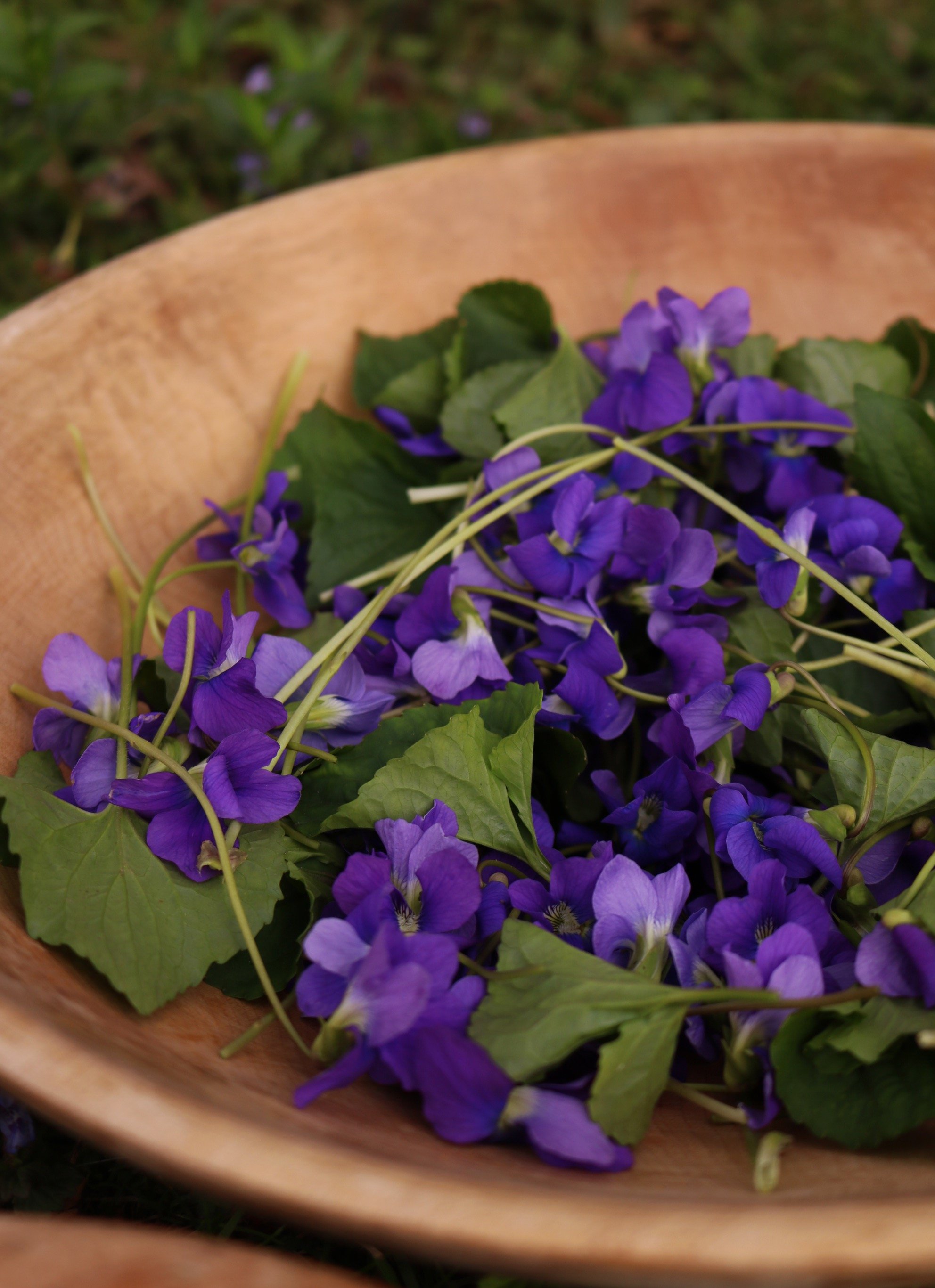Plant Medicine: Wild Violet Benefits and Uses
I always say that one of the best ways to create a productive property is to take advantage of all the medicine that grows freely in ones yard and landscaping. However, this means stepping away from the culturally acceptable “perfect” lawn. A quick google search will reveal that in today’s day and age, violets are viewed as weeds and many spend lots of time and money attempting to rid their yards of them. Did you know that violets—like most “weeds”—are not actually weeds, but extremely beneficial medicinal plants?
The War on Weeds
Once were the days where even in the suburbs, yards were used to grow food for families. Bees were buzzing and butterflies dancing from flower to flower was a common sight in every yard. Victory gardens were valued, cultivated, and even encouraged by the government. Eventually, as convenience culture grew more and more pervasive, the idea of using our own properties to grow our own food phased out, because it was no longer necessary with everything available at the grocery stories. Yards began to shift from bountiful gardenscapes to…green grass. In some cultures, a well manicured yard became a sign of wealth and status. Personally, I would much rather have a yard entangled with different native plants, beautiful flowers that attract pollinators, fruits and veggies growing in every area possible to feed and nourish my family! I would love to see long grass, “weed”-filled yards, and victory gardens make a comeback in the suburbs.
I suppose of course people can do with their lawn what they would like, but I can’t help but wonder how many manicure their yards this way simply because it’s what is culturally expected of us. Most people are entirely blind to the horrific damage caused by their application of neonicotinoids and what it’s doing to our soil, our water, the wildlife, and even our own health. Having a few weeds in the very yard your children and dogs play in is a small price to pay for their safety and health. Although we may often stand alone, we would do well to fight against this modern destruction.
Big pharma knew that if the benefits of medicinal plants are no longer every day knowledge for us, or even physically accessible to us, we then become more dependent on synthetic pharmaceuticals and over the counter medicine. This was beneficial to their wallets, and thus began the war on weeds and the rise of Roundup.
The good news is, there is a different way. Recovering both the knowledge of wildcrafted medicine and the growth of these precious herbs is our way out of their corrupt system. Here on our little suburban homestead, we do not spray our own lawn and we let the dandelions, clovers, plantains, violets and crab grass grow wild. We don’t mind it! In fact we prefer it. We pick and preserve everything that is available to us, with great thanks that the Lord has provided safe and effective means of healing through His creation.
wild violet Benefits
Wild violets grow abundantly and are both edible and medicinal. Amongst dandelions, wild violets are another one of our favorite “weeds” to forage from our property. Both the flower and leaves are edible, but the leaves contain the most medicinal benefits.
The flavonoids and alkaloids found in violets help to lower blood pressure
The salicylic acid found in leaves is wonderful for inflammation related pain relief, acne, warts, and other fungal related ailments.
Extremely high in vitamin C
The mucilage in violets acts as an expectorant and is commonly used for coughs, colds, and flus
Beneficial in the treatment of cancer, especially that of the throat, tongue, and lymph system.
Detoxifies through supporting the liver and acts as a diuretic
Can dissolve cysts and encourage lymphatic flow, especially beneficial for women during their cycle that can cause lumpy and tender breasts (this is what our Breast Health Salve does!)
And so much more! Swelling, inflammation, pain, eczema, acne, cancer, lymphatic flow…this is a beautifully well-rounded herb that you definitely want to keep in your home apothecary.
Harvesting Wild Violets
Not to be confused with the houseplant African Violets (which are toxic), wild violets grow outside and can be identified by their purple/blue flowers and heart shaped leaves. Wild violets do have a toxic lookalike called lesser celandine. While lesser celandine has yellow flowers and glossier leaves, the leaf shape is similar to those of violets. Because of this, it’s best to harvest violets in early spring so you can correctly identify the plant by its purple flowers. Always make sure you are foraging what you believe to be. It’s always a good idea to fully prepare by studying the anatomy before harvesting any wild plants.
Always be sure to forage from areas that have not been sprayed in many years— 7 at the very least as they say that 7 years is the minimum detox period of glyphosate and other herbicides.
Violet root is toxic in excess, but both the leaves and the flowers are safe and can be harvested for use. We harvest both leaves and flowers, but always making sure to leave some for the bees and other pollinators that rely on the early spring flowers!
wild violet Uses
Violets can be used medicinally or simply to add a bit of beauty to your spring meals. One of our most popular use of violets is in our Breast Health Salve due to their benefits to the lymphatic system. My mom and I both use this salve every day. I also enjoy making pink lemonade with the violet flowers, or springtime ice cubes. Here are a few creative ways you can use dandelions in your own home this spring:
Violet-infused oil using dried leaves and flowers
Violet jelly
Springtime ice cubes using the violet flowers and lemon slices
Violet tea/infusion made with fresh leaves and flowers
Violet simple syrup
Violet poultice
Sugared violets
An important disclaimer about wild plants and foraging
I am not a medical professional and nothing written on this blog is medical advice. None of my statements have been evaluated by the FDA (I am legally required to give you this disclaimer).
It is important to do your due diligence before foraging, harvesting, and consuming any type of new medicinal plant.
If you are taking any medications, talk to your doctor about any potential drug interactions.
If you are allergic to anything, make sure whatever you are foraging is not in the same family.
Always research potential side effects, dosage recommendations, and how to properly prepare and consume each medicinal plant. Always make sure you are foraging what you believe to be. Fully prepare and study the anatomy before harvesting wild plants. Do not forage plants from areas that have been sprayed within the past 7 years. I am not legally or morally responsible for the health of any of my readers. Please do your own research.
For more “weeds that heal” check out Rachel Weaver’s book Back Yard Pharmacy. I’d love to hear what you do with wild violets or what you plan to try out this spring! Happy foraging :)
More posts about the home apothecary…
This post is not medical advice and is not a substitute for consulting with your doctor. Always do your own research and talk to your medical health professional before introducing any new herbs into your daily routine. Be aware of any allergies you may have and herbal interactions with medications you take. Nothing in this post has been evaluated by the FDA and is not intended to cure, treat, diagnose, or prevent any disease. This post contains affiliate links.









